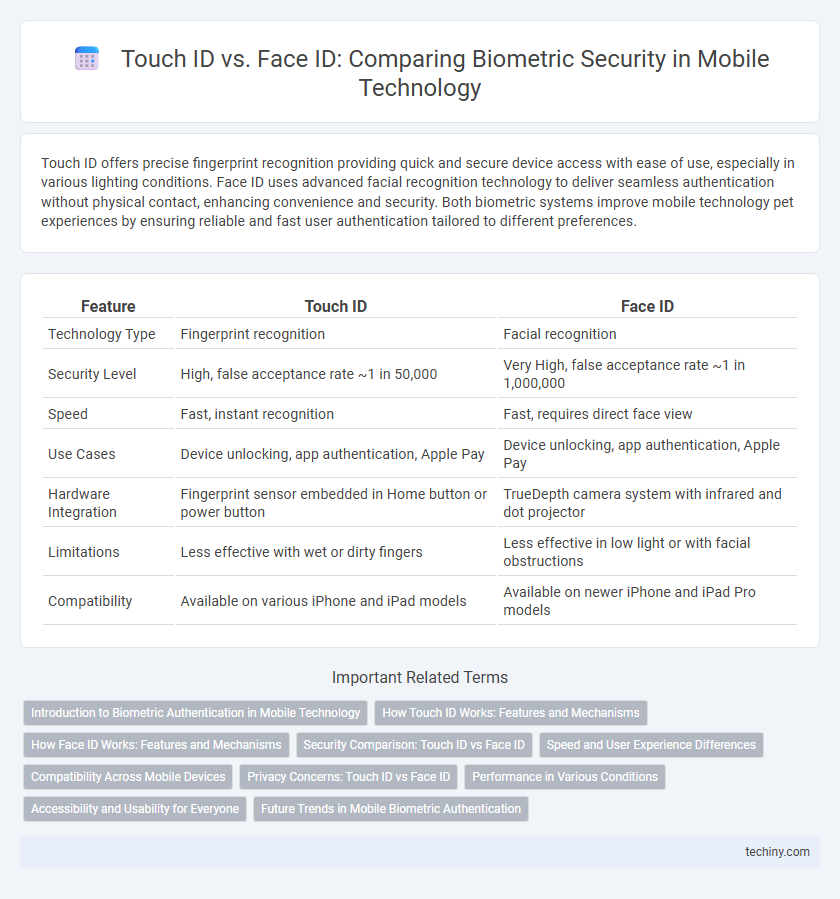Touch ID offers precise fingerprint recognition providing quick and secure device access with ease of use, especially in various lighting conditions. Face ID uses advanced facial recognition technology to deliver seamless authentication without physical contact, enhancing convenience and security. Both biometric systems improve mobile technology pet experiences by ensuring reliable and fast user authentication tailored to different preferences.
Table of Comparison
| Feature | Touch ID | Face ID |
|---|---|---|
| Technology Type | Fingerprint recognition | Facial recognition |
| Security Level | High, false acceptance rate ~1 in 50,000 | Very High, false acceptance rate ~1 in 1,000,000 |
| Speed | Fast, instant recognition | Fast, requires direct face view |
| Use Cases | Device unlocking, app authentication, Apple Pay | Device unlocking, app authentication, Apple Pay |
| Hardware Integration | Fingerprint sensor embedded in Home button or power button | TrueDepth camera system with infrared and dot projector |
| Limitations | Less effective with wet or dirty fingers | Less effective in low light or with facial obstructions |
| Compatibility | Available on various iPhone and iPad models | Available on newer iPhone and iPad Pro models |
Introduction to Biometric Authentication in Mobile Technology
Biometric authentication in mobile technology leverages unique physiological traits such as fingerprints and facial features to enhance device security. Touch ID uses fingerprint recognition by scanning ridges and patterns, enabling quick and accurate user verification. Face ID employs advanced infrared sensors and neural networks to map facial characteristics, offering a hands-free and highly secure authentication method.
How Touch ID Works: Features and Mechanisms
Touch ID uses a capacitive fingerprint sensor embedded in the home button or power button to capture high-resolution fingerprint images by detecting the electrical properties of the skin. The sensor analyzes fingerprint ridges and minutiae points to create a unique biometric template stored securely in the device's Secure Enclave for authentication. This technology enables quick, accurate unlocking and authentication for mobile devices, supporting features like Apple Pay and app access with enhanced security standards.
How Face ID Works: Features and Mechanisms
Face ID uses a TrueDepth camera system that projects and analyzes over 30,000 invisible infrared dots to create a precise depth map of the user's face, ensuring high security and accuracy. Its 3D facial recognition technology adapts to changes in appearance through machine learning, allowing seamless authentication in various lighting conditions. The system employs infrared sensors and flood illuminators to detect the face even in total darkness, enhancing usability and privacy protection.
Security Comparison: Touch ID vs Face ID
Touch ID uses fingerprint biometric data stored securely in the device's Secure Enclave, offering reliable authentication even in low-light conditions and with face occlusions. Face ID employs advanced infrared 3D facial mapping and machine learning algorithms to resist spoofing attempts, providing enhanced security against photo or mask attacks. Both technologies utilize encrypted biometric data storage, but Face ID's dynamic facial recognition adapts to physical changes, delivering higher resistance to unauthorized access.
Speed and User Experience Differences
Touch ID offers rapid fingerprint recognition, enabling quick device unlocking even in low-light conditions or when wearing masks. Face ID utilizes advanced facial mapping and depth sensors to deliver seamless authentication, though it may slow down in direct sunlight or if the user's face is partially obscured. Speed comparisons show Touch ID typically unlocks devices faster, but Face ID enhances user experience through hands-free access and higher security against spoofing.
Compatibility Across Mobile Devices
Touch ID maintains broad compatibility across a wide range of Apple devices, including older iPhones and iPads, making it a versatile biometric security option. Face ID, while offering advanced facial recognition technology, is limited to newer iPhone models and select iPad Pro versions, restricting its availability. Mobile users prioritizing device compatibility often prefer Touch ID due to its integration with a larger ecosystem of mobile devices.
Privacy Concerns: Touch ID vs Face ID
Touch ID stores fingerprint data securely in the device's Secure Enclave, minimizing the risk of biometric data breaches. Face ID uses sophisticated depth-mapping technology and stores facial recognition data locally, reducing exposure to cloud-based vulnerabilities. Both systems have strong encryption, but Touch ID's physical biometric data is considered less prone to false positives and unauthorized access compared to Face ID's facial mapping.
Performance in Various Conditions
Touch ID demonstrates reliable performance in diverse lighting and environmental conditions, including low light and moisture, due to its capacitive fingerprint sensor technology. Face ID offers a quick and seamless unlocking experience, but its effectiveness can be hindered by factors such as strong sunlight, facial obstructions like masks, or changes in appearance. Both biometric systems employ advanced neural networks to enhance accuracy, yet Touch ID generally excels in scenarios with physical interaction while Face ID performs better in hands-free situations.
Accessibility and Usability for Everyone
Touch ID offers precise fingerprint recognition ideal for users with limited facial visibility or those wearing masks, enhancing accessibility in varied environments. Face ID provides seamless facial recognition for quick device access but may struggle with users who have facial differences or require assistive devices, limiting universal usability. Combining both biometric options maximizes accessibility and user convenience across diverse needs and conditions.
Future Trends in Mobile Biometric Authentication
Future trends in mobile biometric authentication emphasize enhanced accuracy and security for both Touch ID and Face ID technologies, incorporating advancements like under-display fingerprint sensors and 3D facial recognition with depth mapping. Innovations in AI-driven algorithms enable faster, more reliable identification while addressing privacy concerns through on-device processing and encrypted data storage. The integration of multimodal biometrics, combining fingerprint and facial recognition, is expected to revolutionize user authentication by offering seamless and robust protection across diverse mobile applications.
Touch ID vs Face ID Infographic

 techiny.com
techiny.com